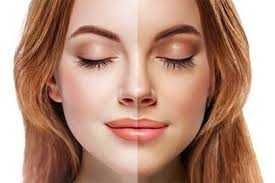Why Do Some Permanent Eyebrows Change Color

There is a variation of reasons behind eyebrow discoloration. Let’s look closer at this problem. The brown color is a secondary color. It is a mix: blue, red, and yellow. Very often red and yellow are unstable in the skin and then you end up with a bluish tone. Applying pigment too deep in the skin, anything that’s deeper in the skin will show with a bluish undertone. It is very important to work on the surface of the skin, so the color stays true.
Climate - sun exposure

Years after an eyebrow procedure has worn, there will be some residual in the skin. It may be warm or it may be cool. The thing is, there is no such thing as a line of pigments that could guarantee that they do not change after years of wear.
The climate has a great deal to do with your pigment color selection, it is important to consider the amount of sun your clients expose on a daily basis.
If your eyebrows have changed color it is very tricky to color correct, that is why it is so important to go to the right person who knows how to fix them.
Sometimes it means that you might need tattoo removal and start the process all over again.
Many times mixing the color in clients' skin will give a satisfying effect, we call this a color correction. However, the problem of discoloration might come back and it is a rather short-term solution.
Pigment Fading

Any pigment oxidizes upon contact with sunlight or artificial light and changes color.
The time at which the pigments are eliminated from the skin varies; it can be anywhere between 5 to 36 months.
Pigment fading depends on many factors, like the chemical composition of the pigment, technique used, age, sun exposure, scarring, and cellular regeneration. The problem occurs when the color changes after time.
Some pigment molecules are more stable than others. Titanium dioxide - white is extremely stable, green - chromium oxide and red - ferric oxide are very stable, while yellow - ferric oxide is not stable.
The macrophage eats the pigments, starting from the least stable. Pigments will be swallowed by macrophages and will eventually disappear over an indefinite period of time.
Use of Medications
The use of some medications may not have initial color distortion, but their residual color may be impacted, after some period of time. Of course, not every person has these side effects but they can happen. Make sure to let your permanent makeup artist know about all prescription and non-prescription drugs, supplements, and topically applied cosmetics.
Do not stop taking your medications before a permanent makeup procedure. If your medication is a contraindication to doing the desired micro-pigmentation your technician will probably advise you to talk to your doctor. If you are under the care of a physician and taking prescribed medications, you should check with your doctor regarding interactions.
Clients taking thyroid medications often need permanent cosmetic procedures re-touched more frequently. Many artists noticed that for some reason their pigment fades a little more quickly. Diabetic clients who are insulin-dependent sometimes do not heal as well also the risk for infection is higher. While taking cholesterol and blood pressure medications there is more chance of a blood droplet coming to the surface of the skin, which leads to more color loss.
Skincare and Skin Conditions
Skincare products and treatments - especially anti-aging can affect the color. Sunscreens, Peelings, Retinols, Glycolic, Hyaluronic, Peruvic, Salicylic, AHA, and Lactic acid products are now in most major brands. Prolonged exposure to these ingredients can lead to fading and pigment discoloration. They may affect permanent makeup and microblading results, as well as laser treatments.
Use of acne treatments that consist of retinoids (Vitamin A) or acids like Glycolic, Lactic makes the skin more sensitive, tattooing could lead to skin irritation and wound. Herbs and supplements can also have an impact on the skin. Some can cause blood thinning or skin thinning. You can not receive permanent makeup if you have active dermatologic disorders, i.e. rosacea, eczema, psoriasis, shingles, and cold sores. Rosacea and eczema leave skin red which affects the color.
The Skin of Color

Depending on ethnicity, clients that have a propensity to hyperpigmentation/hypopigmentation and/or have darker skin complexions may be subject to hyper/hypopigmentation after their permanent cosmetic makeup application.
Professionals need to be aware of post-inflammatory hyperpigmentation in regard to all permanent cosmetic applications. Hyper pigment - the skin will produce more melanin, creating darker pigmentation areas. Hypo pigment - the skin will produce less pigment, creating white areas.

The client’s ethnicity determines the degree of melanin in the skin and the undertone of the skin. Even the ethnicity that you can’t see in your client can affect their healed result as well as their residuals.
Many times after a lip color application, the client will acquire specks of hyperpigmentation in their lips. This seems to be fairly common, and normal skin color may return slowly over a period of months. Hyperpigmentation occurs in Caucasian skin occasionally, although it will most likely occur on clients with heavy concentrations of melanin in their skin.
When considering a person’s skin type, we are most concerned with people that have a 4, 5, or 6 skin type on the Fitzpatrick Phototype Scale.
